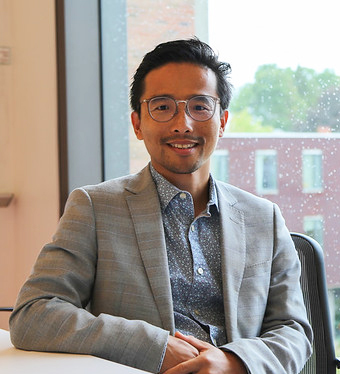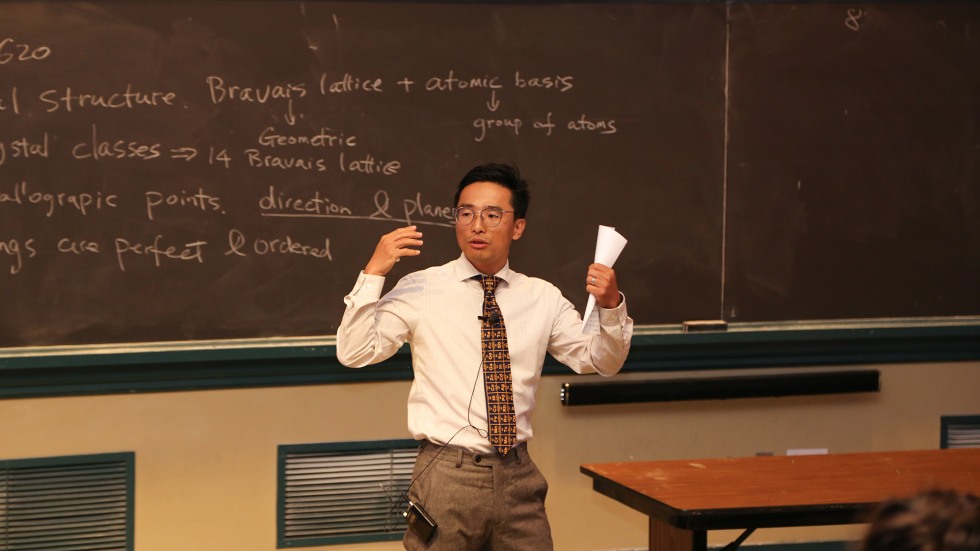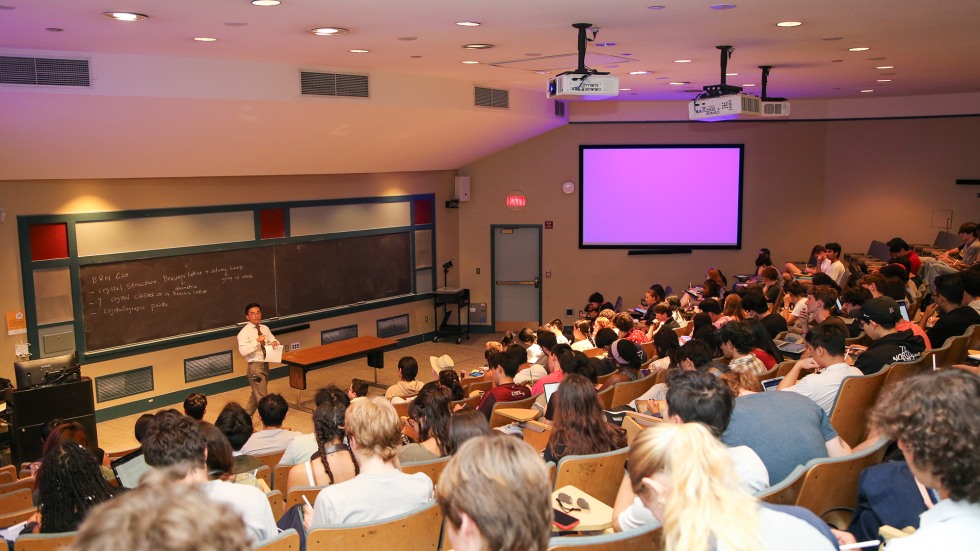 Feng Lin had both a family and professional purpose for leaving Virginia Tech after nine years and joining the faculty of Brown Engineering for the fall 2025 semester. Having grown up near the water in Asia, and completing a post doctoral stint at the Lawrence Berkeley National Lab in California, he likes the ocean. He enjoyed the valley between the Blue Ridge and Allegheny mountains of Blacksburg, Va., but he is certain his children like the water a lot more. So when opportunity came knocking from the Ocean State where Brown University has maintained a significant presence of faculty members and research groups working on areas of research similar to his, he was easily enticed. “In terms of the research direction – the potential to collaborate with people here – the opportunities are enormous,” he said. “There are theorists like Professor Yue Qi, and experimentalists like Professor Brian Sheldon doing a lot of characterization, where I am more in the area of making the materials and battery cells. Certainly, there has been a strong presence of groups working on mechanics of battery materials and growing custom-designed thin films for battery research. I see this as an organization where different research groups can be pieced together to do something big, meaningful, and more comprehensive. I think that’s very powerful.”
Feng Lin had both a family and professional purpose for leaving Virginia Tech after nine years and joining the faculty of Brown Engineering for the fall 2025 semester. Having grown up near the water in Asia, and completing a post doctoral stint at the Lawrence Berkeley National Lab in California, he likes the ocean. He enjoyed the valley between the Blue Ridge and Allegheny mountains of Blacksburg, Va., but he is certain his children like the water a lot more. So when opportunity came knocking from the Ocean State where Brown University has maintained a significant presence of faculty members and research groups working on areas of research similar to his, he was easily enticed. “In terms of the research direction – the potential to collaborate with people here – the opportunities are enormous,” he said. “There are theorists like Professor Yue Qi, and experimentalists like Professor Brian Sheldon doing a lot of characterization, where I am more in the area of making the materials and battery cells. Certainly, there has been a strong presence of groups working on mechanics of battery materials and growing custom-designed thin films for battery research. I see this as an organization where different research groups can be pieced together to do something big, meaningful, and more comprehensive. I think that’s very powerful.”
As a co-founder of Fermi Energy, Inc., Lin also regards Rhode Island’s proximity to the Boston area’s rich innovation ecosystem for technology research, to be a boon. Most of his work falls within the parameters of renewable energy and energy storage and conversion, often conveniently labeled batteries, but how he defines that work is his work in progress.
“I’m quite open in terms of what specific battery chemistry that my group should work on. Early in my career, when students proposed a topic that was not in my comfort zone, I would say, ‘okay, maybe let’s instead focus on this.’ But now I’m giving them more freedom to choose what specific type of battery they want to work on. But, more importantly, I want them to come up with fundamental scientific questions that are in the comfort zone of the group, not just mine, and I want research topics in my lab to have stretchable scopes. We want to figure out why a certain materials phenomenon happens, how to control it, and how to improve it.
“There are over ten different types of battery technologies that people are working on. Even here at Brown, we have people working on different types of batteries. It’s easy for people to get into the argument of which one is going to win,” he said. “But I think the future is really a mixture of different types of battery technologies serving different types of application scenarios. Some of the applications may be more cost sensitive, some could be more power sensitive, or some will be energy density sensitive. It’s really fun to see all these possibilities.”
Fundamental questions are abundant when it comes to investing in alternative solutions, especially alternative battery technologies that focus on replacing or supplementing conventional Li-ion batteries with more sustainable, safe, or higher performing chemistries. Specific elements are currently used mostly because when those materials are made into batteries, they perform well, or as expected.
“Replacing one or two of the elements with a different type, we run into a lot of problems. Some of the problems are just processing and engineering problems,” Lin said. “Some of the problems are fundamental problems. Obviously, as an academic researcher, I want to figure out if it is a fundamental problem, can it be mitigated? Can we still make batteries that run for a specific number of years of charge and discharge use, and have a predictable performance lifetime? At the end of the day, it’s not just about getting a battery that can last long, but about getting a battery that can do the job for you and give you the capability to predict its lifetime.”
Lin said he recently gave his daughter a 15-year-old computer tablet that hadn’t been opened or used in about 12 years. They discovered this tablet in the garage when relocating. Much to her chagrin, and his, the battery would no longer charge. “So that’s the shelf life. Fundamental studies can help us get better at lifetime prediction.
“I want to define myself as a material scientist, as an engineer, that works on the fundamental questions that can be translated into impactful technologies.”
When it comes to impact, Lin both thinks and plans on a large scale. “Scientifically, I have a ten-year plan,” he said. “I encourage my research members to focus on two topics: Number one is the heart of materials science, which are things like phase transformation during thermal processes. That goes back to making materials in a more energy efficient way and triggers down to basic materials science principles, thermodynamics, and also kinetics – basically, how to accelerate materials making without paying a high energy penalty.
“I’m seeing a lot of progress being made in my group on that. I want to continue to do that in the next ten years. And that’s also something I feel that some of the colleagues here, like (Professor and Director of the Initiative for Sustainable Energy) Nitin Padture, have been working on, and that could be something that we can collaborate on.
“The other topic that I’m very much interested in is energy devices with a solid material situated in a liquid environment. In batteries, it’s battery electrodes situated in the liquid electrolyte environment. We have a relatively good understanding of the solid state, or the solid material. But the understanding of the liquid material is not as advanced. Partially because whatever you get into the liquid, it’s hard to predict how they behave. You can think of this as things that you dissolve into liquid. They become more mobile, like fish in a pond. You can’t predict their behavior well, but you know that behavior is impacting the performance of the technology.”
Seven Ph.D. students and a senior research associate have joined Lin at Brown, either enrolling as first-time graduate students, or transferring over from Virginia Tech. One of his current projects is funded by the Department of Energy, which is centered on finding alternative solutions to energy storage. “Sodium ion batteries are more accommodating, in terms of using different types of minerals,” he said. “For example, manganese, iron, titanium – all those elements are more abundant than nickel and cobalt. The key question is making something that competes with lithium ion. Maybe not a vehicle that you can dream about driving 400-500 miles per charge, but maybe fewer miles with a faster charge time, or will serve you in colder environments.” That math is attractive for those with shorter commutes and local drives, but at a certain point, with a shorter charging stop, these alternatives could even make better time on longer road trips. Of course, that technology will have a lasting impact on grid energy storage and data centers as well.

